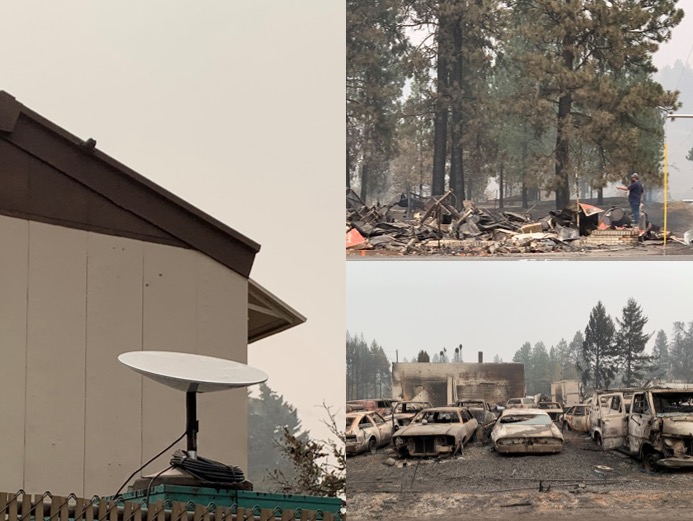
SpaceX Starlink is providing Internet access to Washington state emergency responders in areas ravaged by wildfires. The group has deployed seven Starlink user terminals (i.e. satellite dishes) since it began using the service in early August, as CNBC reported yesterday:
"I have never set up any tactical satellite equipment that has been as quick to set up, and anywhere near as reliable" as Starlink, Richard Hall, the emergency telecommunications leader of the Washington State Military Department's IT division, told CNBC in an interview Monday.
The broadband service has helped both emergency responders and families in wildfire-stricken areas. Hall "has set up terminals in areas that were burned severely to provide evacuated families with wireless calling and Internet access to file insurance claims," CNBC wrote. Hall said he also "did setup to allow kids to do some of their initial schooling."
Hall said Starlink has "easily double[d] the bandwidth" compared to traditional satellite broadband and consistently provides latency of less than 30ms.
Traditional geostationary satellites that orbit at altitudes of more than 35,000km provide latency to residential customers of about 600ms, according to Federal Communications Commission measurements, making them a poor substitute for cable or fiber. Starlink, with its low-Earth orbits of 540km to 570km, can deliver something much closer to the experience provided by wired broadband services, despite skepticism expressed by the FCC.
Compared to Starlink, Hall said that traditional satellite provides "a lot less speed and bandwidth and a lot higher latency in a much larger package." On Monday, Washington's Emergency Management Division said on Twitter that it's happy to have Starlink "as emergency responders look to help residents rebuild the town of Malden, WA that was overcome by wildfires earlier this month."
"Glad SpaceX could help! We are prioritizing emergency responders & locations with no Internet connectivity at all," SpaceX CEO Elon Musk responded.
Hall said that previous satellite services he has used required setup times of 30 minutes to an hour, while it "took him between five and 10 minutes to set up and connect a Starlink terminal," CNBC wrote.
"It doesn't require a truck and a trailer and a whole lot of other additional equipment," Hall said. In the worst cases, Hall said he has "spent the better part of four or five hours with some satellite equipment trying to get a good [connection]. So, to me, it's amazing."
Musk has described the Starlink setup process as "point at sky, plug in," noting that the dishes have actuators that let them point themselves in the right direction. Hall said that SpaceX told him the user terminal "required a clear North-facing shot," but that he got good speeds even in places where the view was "slightly obscured."
Starlink provided free, for now
Washington's emergency use of Starlink "grew organically out of previously unrelated talks," as the state was working "to provide some rural coverage to some of our tribal areas that were not going to get broadband at all for a while," Hall said. Washington state emergency responders currently get Starlink for free, but Hall said that "if we want them long term, then we will have to come back to [the] table and talk about that."
Hall wants to start talks about a long-term deal in the near future. "We want to get as many spun out to as many places as we can, so knowing what the cost is going to be is better sooner rather than later," Hall said.
Recent speed tests by Starlink beta users found download speeds of 11Mbps to 60Mbps and upload speeds ranging from 5Mbps to 18Mbps. SpaceX, which has launched about 700 satellites and has FCC permission to launch nearly 12,000, is planning for up to 5 million users in the US.
Financial analysts at Cowen cast doubt on Starlink's potential to serve that many customers in a research note that got some attention recently. According to Light Reading, "the analysts conclude that Starlink can serve 485,000 simultaneous data streams in the US with 100Mbps speeds if all 12,000 Starlink satellites are operational." But that isn't a realistic assumption because there would never be a situation in which all customers on a broadband network use all of their allotted bandwidth simultaneously. Even if every Starlink customer streamed Netflix in 4K every second of the day (another unlikely scenario), that would only require 25Mbps per household.
Still, there are practical limits, as Musk has said Starlink is geared toward rural areas because it won't have enough bandwidth to serve lots of customers in densely populated cities like Los Angeles. SpaceX has not revealed pricing or an exact date for the launch of commercial service. The service will likely attract a mix of residential, corporate, and government customers. The US Army recently signed a three-year deal with SpaceX to test Starlink.
"emergency" - Google News
September 30, 2020 at 11:56PM
https://ift.tt/34bSGsf
SpaceX Starlink brings Internet to emergency responders in wildfire areas - Ars Technica
"emergency" - Google News
https://ift.tt/2VVGGYQ
https://ift.tt/3d7MC6X
emergency
Bagikan Berita Ini














0 Response to "SpaceX Starlink brings Internet to emergency responders in wildfire areas - Ars Technica"
Post a Comment